Animated videos can be used to grab the learner's attention, tell a story, or illustrate a process. For example, this animated video includes storytelling elements to quickly introduce vocabulary and concepts that are later emphasized during the full eLearning course.
This sample video was built using a rapid animation tool (Powtoon) and then embedded in a course built in Storyline. It could have also been embedded within a Rise course, shown during an instructor-led training, or stand alone as microlearning for employees who need a quick refresher on the components of a SWOT analysis.
Types of animated videos
There are several strategies when developing animated videos and some software is better than others. Here are few different types of styles of animated videos to consider:
- Animated human characters: these can range from realistic avatars, illustrated characters (as in this example), or very characters that have exaggerated cartoon features
- Animated non-human characters: these use non-humans, such as animals, cartoon characters, robots, etc. to serve as the narrator or primary characters.
- Whiteboard drawings: This may or may not include human characters, but instead draw illustrations on the screen as the narration provides information. In many cases, these show a hand holding a pen or pencil during the drawing.
- No characters: Instead the narration supports onscreen text, illustrations, diagrams, charts, or other information with callouts, but does not contain any human or other characters.
Benefits
- Reduce time and cost: Using rapid animation tools and AI-powered narration reduces the development time and cost, when compared to using live actors and filming on site.
- Easy to update: Content changes can quickly be updated, where new scenes can be inserted and still maintain the consistent look and feel. For example, the Twitter bird symbol could be replaced with the new X logo in an animated video more easily than if the logo had appeared in a filmed computer screen.
- Range of movements: Animated characters can show a range of movements and facial expressions or quickly move from one scene to another
Downsides
- Lack of realism: Depending on the software used, animated characters might not show a full range of emotions, have appropriate vocal inflections or tone, or come across as juvenile or as a caricature of a person.
- Software limitations: Each software has limitations. These might related to the ability to synch mouth movement to narration, move characters into desired positions or perform a desired range of motion, customization of character clothing, etc.
- Customization can be expensive: custom animation may be needed to get desired results or meet branding requirements. However, this process is considerably more expensive and time consuming than using readily available rapid animation tools.
At Wieser Learning Solutions, we can help you determine if an animated video is right for your project, and help select the best tool and style of animated video to meet your needs.
